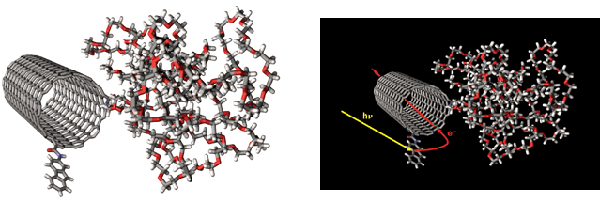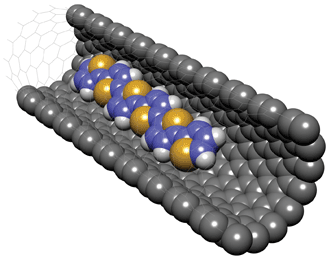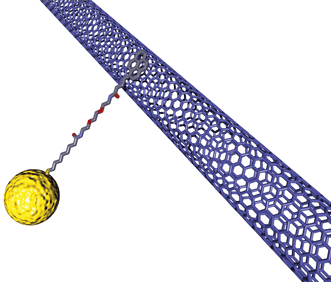They’re cheaper, lighter, flexible and easy to dispose – it’s little wonder that carbon nanotubes are grabbing the attention of solar cell specialists in Europe and beyond.
Since they were first discovered in 1991, carbon nanotubes (CNTs) – and single-walled carbon nanotubes (SWCNTs) in particular – have attracted great attention, thanks to their unique optical properties and versatility.
Low-temperature processing means that CNT-based solar cells are cheaper to make compared with their silicon counterparts, and since nanotubes are mechanically resilient, they also make for more flexible devices.
Although carbon nanotubes offer intriguing physical properties, the power-conversion efficiencies (PCE) remain short of the values achieved by inorganic solar cells. Despite this shortcoming, scientists around the world insist that the potential benefits of developing CNT-based solar cells more than make up for the efficiency shortfall.

A soluble photoactive derivative of carbon nanotubes (Eur J Org Chem, 2006, doi: 10.1002/ejoc.200600196; Carbon, 2009, doi: 10.1016/j.carbon.2009.01.004) that could be studied for photovoltaic applications and photoinduced electron transfer. Images courtesy of Dr. Enzo Menna, professor of organic chemistry at the University of Padova, Italy.
“In terms of PCE, organic materials like carbon nanotubes are in general not competitive with inorganic solar cell materials (which have PCE larger than 40 percent),” said Dr. Bruno Pignataro, professor of physical chemistry at the University of Palermo in Italy. “However, they can be conveniently employed for flexible/plastic solar cells, since these are stable and can be processed at low temperature without altering the plastic substrates, or can be employed for low-power or high-efficiency/cost ratio applications.”
Making solar cells is all about precisely combining materials to maximize the number of charge carriers generated and then to efficiently transfer them to their respective electrodes. During the first 10 years of research, conversion efficiencies achieved by CNT-based solar cells hovered around the 1 percent mark, and some feared that a plateau had been reached in the field. But publications in recent months prove that big jumps in efficiency are still possible.
Current research can be broadly divided into two categories: integrating carbon-nanotube films into traditional solar devices, and fabricating structures with single or few nanotubes.
When it comes to improving the optical and electrical properties of thin films for the next generation of photovoltaic cells, the challenge is to enhance the generation of free charges from excitons at the donor-acceptor interface and their subsequent guidance through the material to the appropriate electrode. The greatest advance for this type of organic photovoltaic technology (based on a planar donor-acceptor heterojunction) was in the introduction of the bulk heterojunction approach.
Working with carbon nanotubes opens up an almost unlimited number of intriguing possibilities; this is because of their versatility and malleability. When a thin sheet of carbon is rolled into a nanotube, it is manipulated to form a tube of particular diameter and twist, defined as its chirality. Each chirality absorbs a narrow range of optical wavelengths, and because several hundred different chiralities are possible, scientists are now able to reach parts of the electromagnetic spectrum never before used by existing solar devices.
“To my understanding, CNTs could be used as absorbers in the infrared spectral range, a part of the electromagnetic spectrum which is usually not really harvested in conventional solar cells,” said Dr. Uli Lemmer, a professor at the Light Technology Institute and Institute of Microstructure Technology, part of the Karlsruhe Institute of Technology (KIT) in Germany.
Large-scale production (around 10 g per day) of high-purity SWCNTs is carried out using a gas-phase chemical vapor deposition process known as the HiPco process. The HiPco raw material consists of a multitude of semiconducting (s-SWCNT) species of varying diameter (Dt), chiral angle or (n,m) index, and each of these species has unique first (S11) and second (S22) optical transitions in the region of around 900 to 1350 nm and around 500 to 850 nm, respectively.
Until recently, researchers tended to build an entire solar cell using CNTs that possess the same chirality (i.e., the same [n,m] value). Such cells can take advantage of only a small fraction of the solar spectrum, effectively wasting the majority of light that shines upon them.
“Therefore, upon selecting the appropriate (n,m) combination of SWCNTs, it is theoretically possible to fabricate a solar cell capable of harvesting light not only in the visible but also the infrared, a spectral region excluded by traditional silicon solar cells,” explained Dr. Benjamin Flavel, leader of the CNTs, Solar Cells and Sensors Group at the Institute of Nanotechnology, also part of KIT.
And this is precisely what a team at Northwestern University in Illinois did.
Dr. Mark Hersam, professor of materials science and engineering at the McCormick School of Engineering, and his Northwestern group collaborated with researchers at the University of Kansas and MIT to develop a new type of CNT solar cell that is twice as efficient as its predecessors.
As described in an August article in Nano Letters (doi: 10.1021/nl5027452), Hersam’s team made a mixture of polychiral – or multiple-chirality – semiconducting nanotubes. This maximized the amount of photocurrent produced by absorbing a broader range of wavelengths.
The scope goes as far as absorbing in the near-infrared, a range that has been inaccessible for many leading thin-film technologies. The structure uses layers of fullerene and single-walled CNTs with diameters of 0.8 to 1.2 nm to achieve record PCEs: up to 3.1 percent.
This is an impressive jump in efficiency for CNT solar cells, but they still fall short of the efficiencies gained by other materials, such as silicon. But since silicon solar cells are relatively expensive to manufacture, CNT alternatives remain an attractive option, particularly if efficiencies can be further improved.

An endohedral photoactive material derivative (Adv Mater, 2010, doi: 10.1002/adma.200903527; J Phys Chem Lett, 2013, doi: 10.1021/jz401073t; Small, 2011, doi: 10.1002/smll.201100319).
The next step for Hersam’s team is to create polychiral CNT solar cells with multiple layers optimized for a particular portion of the solar spectrum, thereby taking advantage of even more light. Additional avenues up for investigation include incorporating other materials, such as organic or inorganic semiconductors, to complement CNTs.
“It’s hard to predict commercialization timelines, but I would think that it will be at least a few years,” Hersam said.
Flavel agrees that the point at which commercialization becomes viable is very hard to predict, and admits that CNT solar cells may never match the industry’s best alternatives when it comes to efficiency.
“But reaching extremely high efficiency levels does not always have to be the goal,” he said. “CNTs have many other advantages (as discussed above), which make up for their current limited efficiency. Additionally, the use of organic materials opens up avenues for flexible displays or panels and would dramatically increase the ease of device disposal.”
In the single-/few-nanotube architecture, photogenerated electrons and holes are typically separated either by an externally applied gate bias or by internal fields at an SWCNT-metal Schottky barrier.
“However, unlike in the case of the SWCNT films, a laser is typically used to address the CNTs due to the high power density required to measure photocurrent from only a few CNTs,” Flavel said. “Hence, the laser source and CNT must be chosen carefully to ensure at least one of the CNT’s optical transitions (usually S22) matches the excitation source.”
From this point of view, these systems could be called nanoscale solar cells, but as the ability to produce power under illumination on the single-nanotube level is yet to be shown, it is perhaps more accurate to describe them as nanoscale photodetectors.
Challenges, future work
Although carbon nanotubes may be cheaper to produce than silicon, they also come with their own unique set of drawbacks. These include issues connected to their synthesis, purification, functionalization, processing and device integration (doi: 10.1039/C1EE02276H).
“One of the biggest challenges to this field – and [this] is true of the carbon nanotube field in general – is the ability to prepare single-chirality [(n,m) pure] SWCNTs on the large scale,” Flavel said. “Despite recent reports demonstrating chirality-selective growth of carbon nanotubes, there is still a great deal of activity looking at post-growth processing methods to obtain SWCNTs on a scale that is easily transformed into a film/device.”

A noncovalent hybrid derivative: Gold nanoparticles have been attached
to carbon nanotubes through sidewall interaction with a pyrene moiety (J
Phys Chem C, 2014, doi: 10.1021/jp505005e).
What is more, the fabrication of macroscale thin films of SWCNTs from a nanoscale object is a challenge, but Flavel predicts that the field will really take off if and when a method for growing SWCNTs of particular chirality “on demand” is discovered.
In other research, combining CNTs with a relatively well understood model semiconductor such as silicon is another one of the latest PV architectures to be realized, and initial results are promising. For example, nanotube-silicon heterojunction solar cells have demonstrated power conversion efficiencies of up to around 14 percent (doi: 10.1002aenm.201200249).
And in recent years, other materials have gained important consideration in the solar cell field, including flexible electronics. For instance, perovskite (a calcium titanium oxide material) appears highly promising, and Dr. Pignataro’s group at the University of Palermo is currently working to develop a new generation of hybrid solar cells with improved efficiencies and stabilities.
Pignataro’s current research combines CNTs, perovskites and semiconductive polymers. “Like in chemical reactions or in acid-base couples, in the solar cells field, properly combining materials for an efficient electron transfer is probably more important than focusing on the discovery of the best material,” he said. “The choice of electrodes and interfaces is also a crucial point.”